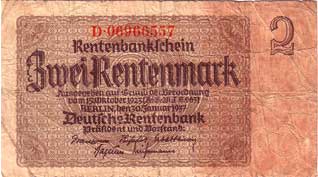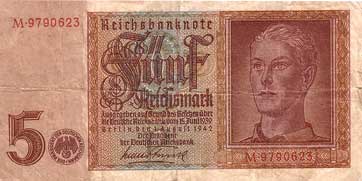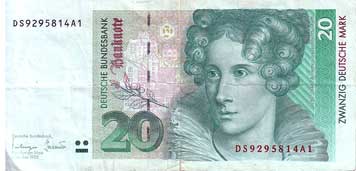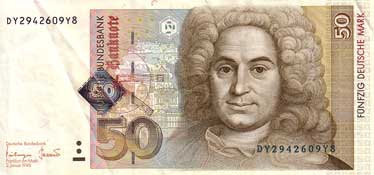 | Pick# 174 - Rentenbank (Stabilization Bank) 2 Rentenmark Note, 1923 Rentenmarkschein Issue, 31 January 1937 The Rentenmark (literally, "Security Mark") (RM) was a currency issued on 15 November 1923 to stop the hyperinflation of 1922 and 1923 in Germany. It was subdivided into 100 Rentenpfennig.
The Rentenmark replaced the Papiermark. Due to the economic crises in Germany after the Great War there was no gold available to back the currency. Therefore the Rentenbank, which issued the Rentenmark, mortgaged land and industrial goods worth 3.2 billion Rentenmark to back the new currency. The Rentenmark was introduced at a rate 1 Rentenmark = 1:1012 Papiermark, establishing an exchange rate of 1 United States dollar = 4.2 RM.
The Rentenmark was only an intermediate currency and was not legal tender. It was, however, accepted by the population and effectively stopped the inflation. The Reichsmark became the new legal tender on 30 August 1924, equal in value to the Rentenmark.
The monetary policy spearheaded by Hjalmar Schacht—the Central Banker—together with the fiscal policy of German Chancellor Gustav Stresemann and Finance Minister Hans Luther brought the inflation in Germany to an end.
The Rentenbank continued to exist after 1924 and the notes and coins continued to circulate. The last Rentenmark notes were valid until 1948. |
 | Pick# 186 - 5 Reichsmark, 1942 Issue, 01 August 1942
Obverse: Portrait of young man at right
Watermark: The number "5" |
 | Pick# 39 - 20 Deutsche Mark, 1 October 1993, 1989-1991 Issue
Obverse: Annette von Droste-Hülshoff at right
Reverse: Quill pen and beech tree at left center, open book at lower right in watermark area
Watermark: Annette von Droste-Hülshoff
Size: 139 x 68 mmAnnette von Droste-Hülshoff (January 10, 1797 – May 25, 1848) was a 19th century German author, and one of the most important German poets. |
 | Pick# 40 - 50 Deutsche Mark, 2 January 1996, 1996 Issue
Obverse: Balthasar Neumann at right, square-shaped Kinegram foil at left center
Reverse: Architectual drawing of Bishop's residence in Würzburg at left center, building blueprint at lower
Watermark: Balthasar Neumann
Size: 146 x 71 mmJohann Balthasar Neumann (January 27, 1687 - August 19, 1753) was a German military engineer and architect who developed a refined brand of Baroque architecture, fusing Austrian, Bohemian, Italian, and French elements to design some of the most impressive buildings of the period, including the Würzburg Residence and the Basilica of the Fourteen Holy Helpers.
The Würzburg Residence is considered one of the most beautiful and well proportioned palace in Europe and the Basilica of the Fourteen Holy Helpers is considered by some as the crowning work of the period. |
 Federal Republic of Germany Paper Money Collection
Federal Republic of Germany Paper Money Collection Federal Republic of Germany Paper Money Collection
Federal Republic of Germany Paper Money Collection